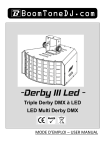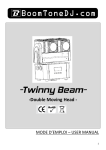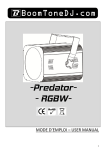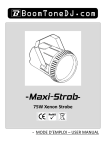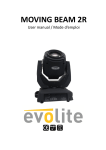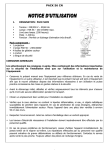Download Dream Led - BoomToneDJ
Transcript
-Dream Led DMX 6 Eyes LED Flower Multi-Flower DMX à LED MODE D’EMPLOI – USER MANUAL Français 1- Instructions de sécurité Avant d’utiliser votre matériel, nous vous recommandons de lire WARNING l’ensemble des instructions de ce manuel. Conservez ce manuel pour une future consultation. Si vous revendez cet appareil, veillez à transmettre également ce manuel d’utilisation au nouvel acquéreur. Déballez entièrement l’appareil ainsi que tous ses accessoires. Vérifiez qu’il n’y a aucun dommage et que l’appareil se trouve en parfait état. Il est important d’utiliser le câble d’alimentation secteur fourni (câble avec terre). Toujours débrancher l’appareil avant une intervention technique ou avant son entretien. Température ambiante maximum pour un fonctionnement optimal de l’appareil : 40°C. Ne pas utiliser l’appareil si la température ambiante dépasse cette valeur. En cas de problème de fonctionnement, arrêtez immédiatement l’appareil. Ne pas essayer de le réparer soi-même. Contactez votre revendeur ou faites appel à un réparateur spécialisé et agréé. Il n’y a aucune pièce remplaçable par l’utilisateur. Ne pas brancher cet appareil sur un bloc de puissance variable type “ Dimmer pack” Afin de réduire et d’éviter tout risque d’électrocution ou d’incendie, ne pas utiliser cet appareil dans un milieu humide ou sous la pluie. Ne pas regarder directement le faisceau lumineux. Cet appareil DREAM LED doit être installé avec un crochet solide et de dimension adéquate au poids supporté. L’appareil doit être vissé au crochet et serré convenablement afin d’éviter toute chute due aux vibrations produites par la machine en fonctionnement. L’accroche de l’appareil doit être sécurisée par une élingue de sécurité. Assurez-vous également que la structure (ou point d’accroche) peut supporter au moins 10X le poids de l’appareil accroché. L’appareil doit être installé par une personne qualifiée et doit être placé hors de portée du public. 1 2- Présentation du DREAM Led 1. Connecteur d’alimentation à fusible intégré : Pour y brancher votre cordon secteur. 2. DMX OUT: Transmet le signal DMX . Connecteur XLR femelle 3 broches. 3. DMX IN: Reçoit le signal DMX. Connecteur XLR mâle 3 broches. 4. Microphone:Pour la détection audio. 5. Dip switch:Pour la sélection des modes de fonctionnement et des adresse DMX. 3- Caractéristiques techniques Tension d’alimentation: AC 230V~50Hz Consommation Electrique: 15 W Source lumineuse : 9W (3 en 1) Fusible: T 3A (AC 230/250V) 7 canaux DMX Dimensions: 285 x 240 x 280 mm Poids: 3.15 kg 2 4- Modes de fonctionnement Le DREAM LED peut fonctionner selon 3 modes différents: • Mode Maître / Esclave • Mode DMX • Mode Manuel A. Utilisation en mode AUTO ou SON avec fonction Maître/Esclave En mode Maître/Esclave, le premier appareil DREAM LED commande les suivants. Ce mode est très pratique lorsqu’il vous faut faire une installation rapide avec un résultat er immédiat. Sur le 1 appareil DREAM LED sélectionnez un fonctionnement en “Maître” ( Switch 9 en position “ON” , voir tableau « 4-3 Mode Manuel » ci-dessous) + sélection du programme . Exemple : Switch 8 « ON » + Switch 9 « ON » = Appareil fonctionne en automatique et envoie les informations en tant que maître aux autres appareils esclaves . Les appareils DREAM LED suivants seront configurés en “Esclave” ( Switch 10 en position “ON” ). B . Utilisation en mode DMX Pour une utilisation en mode DMX , vous devez assigner une adresse DMX à chaque appareil que vous souhaitez contrôler. Cette adresse est définie grâce au DIP Switch 1 à 8 comme indiqué ci-après. 3 Mode DMX (Rappel des valeurs binaires pour constituer votre DMX avec les DIP SIWTCHs). Dip Switch Value #1 #2 #3 #4 #5 #6 #7 #8 #9 #10 1 2 4 8 16 32 64 128 Master DMX adresse 4 Mode DMX (Affectation des canaux DMX pour le DREAM LED) Channel Value 0-3 1 4-127 128-255 Function Off Rotation sens horaire lent vers rapide Rotation rapide anti-horaire lent 2 0-255 Dimmer Rouge 3 0-255 Dilmmer Vert 4 0-255 Dimmer Bleu 0-27 Off 28-55 Fondu 3 couleurs sans rotation 56-111 Fondu 7 couleurs sans rotation 112-139 Changement rotation 140-167 Saut de couleurs avec rotation 168-195 Fondu 3 couleurs avec rotation 196-251 Fondu 7 couleurs avec rotation 252-255 Mode detection sonore 5 de couleurs vers avec 6 0-255 Réglage de vitesse du fondu de couleurs si CH5 est “ON” entre 28-111 7 0-255 Strobe lent vers rapide 5 Mode DMX (Connexion DMX) 1. Si vous utilisez un contrôleur équipé d’une sortie DMX en XLR 5 points, vous devez vous procurer un adaptateur XLR 5 points/3 points. 2. Sur le dernier appareil de la chaine DMX, il est conseillé d’utiliser un « bouchon DMX ». (une résistance de 120 Ohms 1/4W entre le pin 2(DMX-) et le pin 3(DMX+) placée dans un connecteur DMX mâle). 3. Connectez “ à la chaine” les appareils les uns après les autres : Sortie DMX vers Entrée DMX de l’appareil suivant. Le câble DMX ne doit JAMAIS être un câble en “Y”. La liaison DMX-512 transporte un signal à haute vitesse. Les câbles utilisés pour cette liaison doivent être de bonne qualité et en bon état. 4. Chaque appareil doit avoir une adresse DMX bien précise pour qu’il puisse être contrôlé par le contrôleur DMX. ( voir tableau ci-dessus ). 6 Mode MANUEL Vous pouvez utiliser votre DREAM LED en mode manuel sans aucun câble de connecté. Activez les DIP Switch selon vos besoins comme suit : Red X X Green X Blue Red Fast Strobe X X X Green Fast Strobe X Blue Fast Strobe Red+Green Fast Strobe X X X Green+Blue Fast Strobe Blue+Red Fast Strobe X Red+Green+Blue Fast Strobe X Red Slow Strobe X X X X Red+Green+Blue Slow Strobe X Master(Master/Slave Mode) DMX Mode(Address Switch 1-8) X X X X X X X X X Blue+Red Slow Strobe Auto Mode X X Green+Blue Slow Strobe Sound Control X X Blue Slow Strobe Full On X X Green Slow Strobe Red+Green Slow Strobe X X X X X X X X X X X X X X X 7 5-Dépannage Voici quelques suggestions si vous rencontrez des problèmes avec votre appareil DREAM LED. • L’appareil ne fonctionne pas du tout. o Vérifiez le cordon d’alimentation et le fusible. o Assurez-vous que votre prise soit bien alimentée. • L’appareil ne répond pas ou pas correctement aux commandes DMX. o Vérifiez vos câbles DMX o Vérifiez votre adressage DMX o Essayez un autre contrôleur DMX o Vérifiez que vos câbles DMX ne passent pas à proximité de câbles haute tension, ce qui pourrait créer des interférences. • Ne réagit pas au son o Vérifiez le mode de fonctionnement choisi o Vérifiez qu’il n’y a pas de câble DMX branché sur DMX IN o Tapotez directement sur le microphone pour tester sa réactivité. 6- Entretien Un nettoyage extérieur de l’appareil doit être fait régulièrement. Les lentilles doivent être nettoyées pour une luminosité optimum. Si l’appareil est installé dans un environnement poussiéreux ou avec de la fumée cet entretien régulier est très important. Il est possible qu’un nettoyage des optiques par l’intérieur soit également nécessaire. Débranchez l’appareil avant toute intervention ! Utilisez un chiffon propre avec très peu de liquide vitre. Toujours bien sécher les parties nettoyées. 8 English 1- Safety Instructions Please read the instructions carefully which include important WARNING • information about the installation, operation and maintenance. Please keep this User Manual for future consultation. If you sell the fixture to another user, be sure that he also receives this instruction booklet. • Unpack and check carefully there is no transportation damage before using the fixture. • It’s important to ground the yellow/green conductor to earth in order to avoid electric shock. • Disconnect main power before servicing and maintenance. • Maximum ambient temperature is Ta : 40℃. Don’t operate it where the temperature is higher than this. • In the event of serious operating problem, stop using the fixture immediately. Never try to repair the fixture by yourself. Repairs carried out by unskilled people can lead to damage or malfunction. Please contact the nearest authorized technical assistance center. There are no user serviceable parts inside the fixture. • Do not connect the device to any dimmer pack. • To prevent or reduce the risk of electrical shock or fire, do not expose the fixture to rain or moisture. • Do not look directly at the LED light beam while the fixture is on. • Do not touch any wire during operation . • The unit should be mounted via its screw holes on the bracket. Always ensure that the unit is firmly fixed to avoid vibration and slipping while operating. Always ensure that the structure to which you are attaching the unit is secure and is able to support a weight of 10 times of the unit’s weight. Also always use a safety cable that can hold 12 times of the weight of the unit when installing the fixture. • The equipment must be fixed by professionals. And it must be fixed at a place where is out of the touch of people and has no one pass by or under it. 9 2- Unit Description 1. Mains input:IEC socket and integrated fuse holder, connect to main power cable. 2. DMX OUT: Transmit DMX signal by 3-Pin XLR female socket. 3. DMX IN: Receive DMX signal by 3-Pin XLR male socket. 4. Microphone:Receive audio signal for sound activated. 5. Dip switches:For MODE selection and DMX Addresses 3- Technical Specifications • Input Voltage: AC 230V~50Hz • Power consumption: 15W • Light Source: 9W (3 in 1) LED • Fuse: T 3A (AC 230/250V) • • 7 DMX Channels Dimension: 285 x 240 x 280 mm • Net Weight: 2.6kg • Cross Weight: 3.15kg 10 4- Function MODE 3 ways to operations for the DREAM LED: • Master/Slave operation • Universal DMX controller • Manual operation A. By Master/Slave Built-in Preprogrammed Function ( AUTO or SOUND) By linking the units in master/slave connection, the first unit(Master)must be turned Dip switch 9 “ON”, then will control the others to give a coordinate automatic light show and it’s good for instant shows. In this mode, the other unit(Slave)must be turned Dip switch 10 “ON”. The first unit is easy to recognize by nothing in its DMX input jack. The others of chains (Slave) will have DMX cables plugged into the DMX input jacks (daisy chain). Example : Switch 8 “ON” + switch 9 “ON” : unit will work in Auto program and will be the “Master” B. By DMX When using a universal DMX controller to control the chain of units, you have to set DMX address by Dip switches from 1 to 8 to make sure all the units will receive its DMX signal. Please refer to the following diagram to know how to address your DMX 512 system in the binary code. 11 Universal DMX controller (DMX 512 Address Chart ) Dip #1 #2 #3 #4 #5 #6 #7 #8 #9 #10 Value 1 2 4 8 16 32 64 128 Master DMX 12 Universal DMX controller ( DMX 512 Value) Channel Value 0-3 1 4-127 128-255 Function Off Clockwise fast to slow Counter Clockwise slow to fast 2 0-255 Red dimmer 3 0-255 Green dimmer 4 0-255 Blue dimmer 0-27 Off 28-55 3 colors fade without rotation 56-111 7 colors fade without rotation 112-139 7 colors change with rotation 140-167 7 colors jump with rotation 168-195 3 colors fade with rotation 196-251 7 colors fade with rotation 252-255 Sound active 5 6 0-255 Color change speed from slow to fast(when CH5 on 28-111) 7 0-255 Strobe from slow to fast 13 Universal DMX controller ( DMX Connection) The DMX 512 is widely used in intelligent lightings and with a maximum of 512 channels. 1. If you using a controller with 5 pins DMX output, you need to use a 5 to 3 pin adapter-cable. 2. At last unit, the DMX cable has to be terminated with a terminator. Solder a 120 ohm 1/4W resistor between pin 2(DMX-) and pin 3(DMX+) into a 3-pin XLR-plug and plug it in the DMX-output of the last unit. 3. Connect the unit together in a ‘daisy chain’ by XLR plug from the output of the unit to the input of the next unit. The cable can not be branched or split to a ‘Y’ cable. DMX512 is a very high-speed signal. Inadequate or damaged cables, solder joints or corroded connectors can easily distort the signal and shut down the system. 4. Each lighting unit needs to have an address set to receive the data sent by the controller. The address number is between 0-511 (usually 0 & 1 are equal to 1). 14 Manual Mode You can use your DREAM LED in Manual Mode without any cable connected Please follow this switch table : Red X X Green X Blue Red Fast Strobe X X X Green Fast Strobe X Blue Fast Strobe Red+Green Fast Strobe X X X Green+Blue Fast Strobe Blue+Red Fast Strobe X Red+Green+Blue Fast Strobe X Red Slow Strobe X X X X Red+Green+Blue Slow Strobe X Master(Master/Slave Mode) DMX Mode(Address Switch 1-8) X X X X X X X X X Blue+Red Slow Strobe Auto Mode X X Green+Blue Slow Strobe Sound Control X X Blue Slow Strobe Full On X X Green Slow Strobe Red+Green Slow Strobe X X X X X X X X X X X X X X X 15 5. Troubleshooting Following are a few common problems that may occur during operation. Here are some suggestions for easy troubleshooting: • The fixture does not work, no light o Check the connection of power and main fuse. o Measure the mains voltage on the main connector. • Not responding to DMX controller o DMX LED should be on. If not, check DMX connectors, cables to see if link properly. o If the DMX LED is on and no response to the channel, check the address settings and DMX polarity. o If you have intermittent DMX signal problems, check the pins on connectors or on PCB of the fixture or the previous one. o Try to use another DMX controller. o Check if the DMX cables run near or run alongside to high voltage cables that may cause damage or interference to DMX interface circuit. • Some fixtures don’t respond to the easy controller o You may have a break in the DMX cabling. o Check the LED for the response of the master/ slave mode signal. • No response to the sound o Make sure the fixture does not receive DMX signal. o Check microphone to see if it is good by tapping the microphone. 6. Fixture Cleaning The cleaning of internal must be carried out periodically to optimize light output. Cleaning frequency depends on the environment in which the fixture operates: damp, smoky or particularly dirty surrounding can cause greater accumulation of dirt on the fixture’s optics. Clean with soft cloth using normal glass cleaning fluid. Always dry the parts carefully. Clean the external optics at least every 20 days. Clean the internal optics at least every 30/60 days 16 17


















